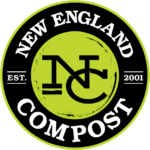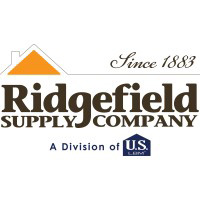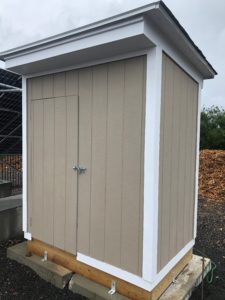The goal of this project is to create a self-sustaining closed loop composting system for transforming residential food waste into an end-product for community and agricultural use. This innovative project demonstrates that municipalities can manage food waste locally, reduce the carbon footprint of offsite disposal and contribute to the waste diversion goals of the state.
This project uses an “Aerated Static Pile (ASP) Composting” process. The mixture of carbon (leaves) and nitrogen (food scraps) are placed on the solar powered ASP piping system. The solar panels power a timed blower which forces air into the perforated piping to circulate air through the composting pile. The system maintains proper moisture and oxygen levels needed to produce a high-quality compost.
This project increases access to compost for residents, community garden groups, and local farmers for use as an alternative to synthetic fertilizers. It also provides the municipality with readily available compost for storm water management and erosion control.
For active participants of the Ridgefield Food Scraps Recycling Program compost is available. For more details
email Town of Ridgefield Recycling Coordinator Tiffany Carlson at recyclingcoordinator@ridgefieldct.org
Want to join the food scraps program?
Are you interested in separating your food scraps from your trash so it can be made into compost, but don’t want to do it in your back yard? Here’s everything you need to know to participate in the Ridgefield food waste drop-off program. Click on the topics below for more information.
How does the program work and what does it cost?
There is no fee to residents to drop-off food waste and/or acceptable organics. However, an annual transfer station permit is required to participate. Click here to print the Town of Ridgefield transfer station permit application.
It is very important that participants bring ONLY acceptable items. The full list of acceptable items are in the next drop down menu.
Participants simply dump their own container out into a designated collection bin at the RECYCLING CENTER located at 59 South Street, Ridgefield. Do not bring the food waste to the transfer station.
IMPORTANT – Please DO NOT contaminate the compost. Remove plastic ties, stickers, twist ties and DO NOT use plastic bags. It’s important to note that contaminated material cannot be processed into compost. It will be disposed of as MSW (Municipal Solid Waste aka trash) and sent to a waste-to-energy plant, which adds cost to the program.
Please take notice that the material you drop off may be examined for contamination by the transfer station attendant. If the attendant believes you are repeatedly violating the rules of acceptable material you risk being banned from the program. The success of the program is dependent on participants being mindful and bringing only acceptable material.
The organic material collected will be brought to the ASP Composting site at the top of the transfer station by staff. Staff will incorporate the food waste with municipal leaves and process the material into compost. When the compost has cured and is ready for use it will be available for the community to use throughout the year.
Details on if the compost will be free to residents and or businesses is still to be determined and will be posted here in the coming weeks.
Acceptable waste items
REMEMBER – ONLY the items listed below are allowed in your bin.
No PLASTIC items, stickers, rubber bands or twist ties!
- Houseplants & Flower Bouquets
- Flower & Vegetable Garden Clippings
- Fruits & Nuts (including pits)
- Vegetables ***Remove stickers, bands and ties***
- Bread, Pasta & Grains
- Sauces, Soup & Gravy
- Coffee Grounds & Filters
- Tea Bags
- Egg Shells
- Meats & Poultry (including bones)
- Dairy Products
- Fish & Shellfish
- Plate Scrapings
- Spoiled food
- Fridge leftovers
- Brown Paper Towels & Napkins (free of cleaning products*)
We will accept dirty paper towels that you used for cleaning up food spills, mud, or wiping down your countertops if you used natural cleaning ingredients like vinegar and baking soda. Vinegar and baking soda are organic materials that will break down in a compost pile just like food.
Otherwise, NO. Do not put paper towels in your collection bin if you used your paper towels to clean up messes like paint, toxic chemicals, or used harsh cleaning products. Harsh chemicals and inorganic materials will not properly break down and are likely to contaminate the finished compost
Satellite Collection Locations
For your convenience satellite collection containers are now available 24/7.
Collection containers are locked at all times and can be opened using a mobile app.
Download the app here from Apple
Download the app here from Google
Click here to learn more about these special collection containers.
LOCATIONS:
59 South Street, Ridgefield (outside the recycling center)
- Convenient 24/7 access. Food scraps drop off when you need it
- User-friendly control from your smart phone thru MetroKey app
- Easy to operate – use the foot pedal or lift the top hatch to access
- Keep the material contaminant fee – check the reminder page if you’re not sure
- Secure, encryption of your account information
- Food scraps are neatly contained until pick up
Can I add items that say "compostable"?
For the success of our program we are asking residents to stick to our published list of acceptable items (see below). Even though companies can label and market their products as “compostable” or “compostable in a commercial facility” they may not actually be compostable or accepted by the composting facility. For these reasons and more, please leave them out of the program.
Collection Container
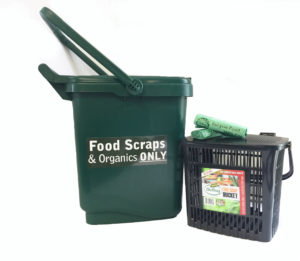
You may collect your food scraps and organic waste in your own bucket such as a 5 gallon pail. Or you may purchase a collection kit from the HRRA. The collection kit consist of a 1.5 gallon kitchen bin, 2 rolls of compostable bags (50 bags total) and a 6 gallon Ec0-Caddy with lock lid. A $50 value.
CLICK HERE and fill out the online order form.
The kit is $15.00 if you pay by check (PAYABLE to the “HRRA”) or $16.05 if you pay by credit card.
Checks can be dropped off at the Recycling Center or mailed to HRRA, 162 Whisconier Road, Brookfield CT 06804
Using compostable bags?
The compostable bags provided are for your convenience and are meant to help eliminate the yuck factor. You do not have to use the compostable bags and we welcome individuals who wish to use just their containers to collect waste.
If you do choose to use compostable bags, you are required to use only bags approved by the program. At this time Biobags are the only approved and certified compostable bags we will accept. While supplies last, the HRRA is providing BioBags to participants. If you wish to purchase your own supply you can find them online from many retailers.
PLEASE NOTE, compostable bags are meant to break down. They do have a shelf life. We do not recommend buying in bulk unless you are planning to share and or use them within their recommended shelf life which is approimatley one year.
Why should I compost
The study found that composting organic waste versus landfilling it can reduce more than 50% of carbon dioxide-equivalent greenhouse gas emissions, for a total of 2.1 gigatons between now (2020) and 2050 if climate change is curbed to a 2 degree Celsius rise in the average global temperature. However the emission savings from landfill diversion is only one benefit of composting. Read more about the study
Separating your food scraps for compost is easy and provides many benefits, some of which are listed below:
- Composting reduces household garbage and can save you money. It removes the “smelly trash” so you can reduce the number of times your hauler collects your waste or the number of times you need to visit the transfer station.
- Since food waste on average makes up 24% of the waste stream and is often the heaviest material in your trash, reducing the weight by composting will also save you money.
- Compost is beneficial to the environment. It is a unique soil amendment because of its ability to hold moisture and soluble minerals.Composted organics are beneficial, because they:
- Maximize plant growth.
- Effective at preventing soil erosion.
- Aid in Stream and land reclamation.
- Reconstruction of wetlands.
- Help with storm water management.
- Reduces the need for fertilizers.
- Reduces the need for pesticides.
- Improves the over all health of soil.
What is the Ridgefield Composting Project?
The Housatonic Resources Recovery Authority in partnership with the Town of Ridgefield is building an onsite composting system for food waste. The food waste will be added to leaves using an Aerated Static Pile (ASP) Composting system. Learn more below.
The history and vision
In 2014 the HRRA developed and tested the first municipal organics curbside collection program of its kind in the state in Bridgewater, CT. The pilot program proved to be successful in engaging participation with the public. Approximately 16% of the town took part in separating their food waste from the waste stream. The material collected was nearly free of contamination and was sent to a commercial facility in a neighboring town to be processed into compost. Each spring the compost is returned to the residents to be used in their home gardens and projects. At the end of the pilot phase, residents were not willing to pay for the collection and the curbside collection program ended. Taking cost into consideration and not wanting the source separation of food scraps to stop, the HRRA transitioned the collection to a drop-off program, which allowed residents to drop-off at no additional cost. Residents now bring their food waste to the town recycling center and a private hauler then transports the material to the local commercial processor and the compost is then returned in the spring. This program was then duplicated and implemented in Newtown, New Fairfield, Redding, and Ridgefield, Connecticut. Each town’s programs are paid for either by transfer station permit fees, drop-off fees or by the general fund.
The major cost of these programs is transportation and disposal fees. The cost has prohibited municipalities from expanding their programs and threaten their long-term existence. The HRRA believes the solution to a successful self-sustainable program is on-site composting.
Not only would composting on-site reduce the burden of cost, but it would also reduce the carbon footprint by removing the added transportation to dispose of the material and to transport it back to the community for use. Lack of funding and professional expertise had prevented the HRRA from moving the program in this direction until 2021 when the USDA offered their Community Compost and Food Waste Reduction (CCFWR) grant and the Recycle CT Foundation released the Lee Sawyer Grant.
Organics programs provide the largest opportunity to increase Connecticut’s waste diversion goals. According to the 2015 waste composition study (by CT DEEP), over 926,000 tons of readily compostable organics were disposed, or nearly 40 percent of total MSW disposal. This includes over: 519,000 tons of food waste; 56,000 tons of yard waste (e.g., branches and stumps, pruning and trimmings); 100,000 tons of leaves and grass; and 249,000 tons of compostable paper (e.g., uncoated paper cups and plates, paper food cartons, napkins, and paper towels).
Food waste is generated at every stage of the supply chain. When food is wasted, we are also wasting the fresh water, chemicals, energy, and land used to produce food. Opportunities exist to reduce food wasted by businesses and households as well as work with businesses and farms to recover more food for humans and animals. The top growth priorities for organics are to strengthen and expand both the collection system and to expand processing capacity.
There are 118 active leaf composting facilities in Connecticut, with a combined throughput of over 775,000 cubic yards per year of incoming feedstock. These include 86 municipal facilities, private facilities, and seven farm-based facilities. Ten of the facilities are identified as accepting grass. Municipal operations tend only to accept leaves generated by that town and may also provide small quantities of finished compost to residents for free or at a nominal charge.1
There is no greater need than now. In August of 2020, the Connecticut Department of Energy and Environmental Protection created the CT Coalition for Sustainable Material Management (CSSMM) to address the concerns of solid waste capacity in the state. Connecticut’s waste management system is in crisis due to aging Waste-To-Energy infrastructure, no operating landfills and only two commercial composting and one AD facility operating to manage food waste in the entire state. The CSSMM called upon state and municipal leaders to work together to discuss and create innovative programs and investments to reduce municipal solid waste tonnage to prevent municipal solid waste being shipped out of state to landfills.
Through the Organics working group of the CSSMM solutions were discussed for state mandates to be put in place to drive diversion through policy. In preparation for the possible unfunded mandate the Housatonic Resources Recovery Authority has determined that municipal onsite composting would be the most sustainable, economically, and environmentally solution for expanding residential organics diversion from the waste stream and must be implemented immediately.
1. Reference
Objectives and Procedures
The overall objective of this project is to demonstrate that municipalities can create a closed loop sustainable composting system to manage food waste locally, reducing the carbon footprint of offsite disposal and contributing to the waste diversion goals of the state. This project will increase access to compost for residential, community garden groups and local farmers without relying on synthetic fertilizers and empower municipalities to use readily available compost for stormwater management and soil erosion. A secondary goal is to create an enhanced educational program for back-yard composting for residents who wish to manage their food waste at home and have readily available compost. The third objective would be using the platform of waste reduction and composting to introduce education and tools to use on food recovery efforts at local farms, in schools and at home to prevent the waste being generated in the first place.
Project planned procedure:
Step 1.) Build the Aerated Static Pile (ASP) Composting system. With the help of our partners Oak Ridge, Ridgefield Public Works, New England Compost and RACE volunteers
Step 2.) Expand public education and outreach. Announce the new collection and composting system at the Ridgefield Municipal Transfer Station and the future availability of ready to use compost. The HRRA and RACE will lead this effort through social media campaigns, newsprint, community events and special event kick-offs. The education campaign will cover waste reduction and the relationship of food recovery which includes ways to avoid over buying to donating. In addition, the education campaign will introduce the food waste composting initiative, what they can do with food scraps from back yard composting workshops, to bringing their food scraps to the drop-off themselves or hiring Curbside Compost. Waste disposal must be easy and convenient and meet the needs of the diversity of the community.
Food recovery – HRRA and RACE. The waste hierarchy starts with “reduce and reuse” and this can be applied to food waste as well. We know that the USDA estimates consumer food waste at about $161 billion annually or about $500 per person per year. This is a combination of waste directly from farms, retailers, processing and packaging plants and 42% from consumers. Our goal is to bring public education and awareness to local farmers and residents (consumers) through our partnership with the community organization RACE. Tiffany Carlson from RACE and HRRA Staff will participate in in-school presentations and when necessary due to Covid virtual, to teach students in grades K-12 the importance of preventing food waste and promoting food donations to local churches, food pantries and community shelters. In addition, the group will partner with local farmers to introduce them to food hubs for produce that otherwise would not sell in their stands or retail orders. The HRRA will partner with local Sunny Meadow Farm and their farmer Jon Lindblom to provide assistance with networking and encourage other farms to donate unwanted produce that otherwise will be wasted. The HRRA would like to provide collection boxes for the produce to be transported to local community drop sites such as churches, food pantries and shelters. The boxes are intended to be reused as often as possible. We want to remove any barriers for collection and transportation of the material.
Step 3.) Collect material to compost: Residents will drop-off their food waste to a designated area at the local transfer station. Oak Ridge Employee Chris Foster will assist residents. The owner and operator of New England Compost, Jeff Demers will act as our paid consultant/teacher/advisor who will assist us in incorporating the proper ratio of food waste (nitrogen) to municipal leaves (carbon). Given the scale of the expected material we will purchase a skid steer to move material.
Step 4.) Composting process: This project will use a “Aerated Static Pile (ASP) Composting” process. Jeff Demers will place the mixture on the ASP piping system. The ASP will be solar operated. The solar panel will control a 1.5 horsepower blower that is set to a timer. The timer will run at designated intervals. The solar powered blower will be connected to rigid and flexible perforated piping that will push air through the composting pile. This will allow us to maintain proper moisture and oxygen levels. It is important to maintain proper airflow for the microbial population, that breaks down the organic matter.
Step 5.) Covering the pile will maintain heat that is needed to kill weed seeds and pathogens. It will also stop heavy rainstorms from washing material away as well as preventing too much water soaking the pile that could reduce the efficiency of the process.
Finished compost is the best cover during the first phase of composting. The finished compost acts as a natural biofilter that will prevent odor when the air is blown through. Until we get finished product, we will use a synthetic cover.
Step 6.) Monitoring the compost – Throughout the program. New England Compost and Ridgefield Public Works will monitor the compost weekly using temperature probes to monitor internal temperatures. Monitoring will occur on an ASP system to ensure that we have killed weed seeds and pathogens the pile must reach a temperature of 131 degrees for a minimum of three days.
Jeff Demers and Public Works will remove the pipes, and a skid steer will be used to homogenize the material and then let the pile sit for 2 weeks to cure.
Step 7.) Curing the compost – Once the pile has cured, the material will be screened to make a uniformed product ready for distribution to the community. The skid steer will assist in moving the finished product to a location where residents, local farmers and community garden groups along with public works can access it for use. Residents and community members will pick up the compost by bringing their own containers. Shovels will be available for use. When needed for larger distribution public works will be on hand to load material with the skid steer. The compost will be available at no charge. Note: there will be an up-front disposal fee that will be used to cover future cost including giving away compost to residents. The facility is open 6 days a week 7am to 3pm to make compost easily accessible.
Step 9.) Monitor and Measure – The HRRA staff will monitor and collect data on the program to track the programs progress. The weight of the material collected will be measured and used as a gauge of success or need for adjustment. The number of residents using the drop-off program will be tracked weekly. The amount of compost being produced, and the amount of material given away will also be monitored. HRRA will also survey participants throughout the project. Information will be used to improve gaps or work off the positive feedback to increase participation and outreach.
The anticipated economic benefits of an on-site self-sustainable composting site is the ongoing cost savings to municipalities. The current organics program involves hiring a food scraps hauler to transport the food scraps to the farm and then purchase the compost to be delivered to the transfer station. The major cost of the existing program is transportation and disposal fees, which has prohibited municipalities from expanding their programs and threaten long-term existence. In addition, municipalities will benefit economically from having compost readily available for stormwater management and soil erosion, rather than outsourcing.
The on-site self-sustainable composting program has the potential to be replicated. The long-term goals include facilitating the implementation of the system to other municipal locations in the region to reduce the solid waste stream and increase the use of compost to all of the region.
- Self-Sustainability
The self-sustainable composting site will continue beyond the end of the project period. The Federal Funds will assist in purchasing the materials that are a one-time fee and assist in covering the contractual costs for the necessary training from Jeff Demers of New England Compost. Mr. Demers will train Ridgefield Public Works, Transfer Station operators, and HRRA staff. Thereafter, these departments will work in conjunction to continue the program.
In return, the long-term goal is to implement this knowledge and replicate the program in additional municipal locations in the HRRA region.
Project Summary/Abstract
Connecticut’s waste management system is in crisis due to aging Waste-To-Energy infrastructure. The current plan is to begin diverting MSW to out of state landfills. This program will help avoid that option in the future.
Very few municipality in the state of CT have attempted to create a project for a self-sustaining closed loop system to manage food waste while utilizing the end-product for community and or agricultural use. This innovative project will demonstrate that municipalities can create a closed loop sustainable composting system to manage food waste locally, reducing the carbon footprint of offsite disposal and contributing to the waste diversion goals of the state.
The self-sustainable municipal composting site will build on the existing food scraps program at the Ridgefield Recycling Center. The end-users who will benefit from this program include residents, town of Ridgefield, local private haulers, agricultural producers who need readily available compost, community garden groups who rely on local resources and the state of Connecticut as a whole due to the looming waste crisis and the need to address the large percentage of food waste entering the waste stream.
Residents will benefit from the program as they will have multiple methods of disposal for food waste as well as access to compost without relying on synthetic fertilizers. In addition, the program includes education program for residents who wish to learn more about backyard home composting.
Private, local haulers will have access to use the transfer station for residents who wish to pay for the food waste curbside service locally.
In addition, the program will benefit municipalities in that they will have readily available compost for stormwater management and soil erosion. According to EPA, compost-based stormwater best management practices (BMPs) combine two important EPA initiatives: Sustainable Materials Management (SMM) and National Pollutant Discharge Elimination System (NPDES) stormwater regulations. The compost based BMPs, which include compost blankets, compost filter berms, and compost filter socks, provide particularly effective stormwater treatment when used in construction and post-construction stormwater BMPs. Compost retains a large volume of water, thus helping to prevent/reduce erosion, reduce runoff, and establish vegetation. 2
Through demonstrating the effectiveness of on-site composting this project could be recreated across the state to address the concerns with solid waste capacity at the local level.
The state of Connecticut will benefit from self-sustainable composting sites as municipalities will have less reliance on landfilling and waste-to energy plants.
2.https://www.epa.gov/sustainable-management-food/reducing-impact-wasted-food-feeding-soil-and-composting
What is an ASP Composting Process?
This project will use a “Aerated Static Pile (ASP) Composting” process. The ASP will be solar operated. The solar panel will control a 1.5 horsepower blower that is set to a timer. The timer will run at designated intervals. The solar powered blower will be connected to rigid and flexible perforated piping that will push air through the composting pile. This will allow us to maintain proper moisture and oxygen levels. It is important to maintain proper airflow for the microbial population, that breaks down the organic matter.
Learn more about ASP Systems and Composting Here
Food Recovery
The waste hierarchy starts with “reduce and reuse” and this can be applied to food waste as well. We know that the USDA estimates consumer food waste at about $161 billion annually or about $500 per person per year. This is a combination of waste directly from farms, retailers, processing and packaging plants and 42% from consumers. Our goal is to bring public education and awareness to local farmers and residents (consumers) through our partnership with the community organization RACE.
RACE and HRRA Staff will participate in in-school presentations and when necessary due to Covid virtual, to teach students in grades K-12 the importance of preventing food waste and promoting food donations to local churches, food pantries and community shelters.
In addition, the group will partner with local farmers to introduce them to food hubs for produce that otherwise would not sell in their stands or retail orders. The HRRA will partner with local farms to provide assistance with networking and encourage other farms to donate unwanted produce that otherwise will be wasted. The HRRA would like to provide collection boxes for the produce to be transported to local community drop sites such as churches, food pantries and shelters. The boxes are intended to be reused as often as possible. We want to remove any barriers for collection and transportation of the material.
Who was Lee Sawyer?

The Ridgefield Solar ASP Compost project was paid for in part by the Lee Sawyer Community Waste Reduction and Recycling Grant, which supports waste reduction and reuse in addition to recycling and composting efforts.
The grant program is named in memory of former DEEP Chief of Staff Lee Sawyer, who died unexpectedly on Oct. 31, 2020. Lee was incredibly dedicated to the mission of DEEP, and was instrumental in the creation of the RecycleCT Foundation.
The RecycleCT Foundation is a nonprofit organization whose mission is to promote the importance of managing materials more sustainably through waste reduction, reuse, recycling and composting that encourage people, government entities, businesses, schools and organizations to adopt these practices as part of their everyday lives or operations. RecycleCT provides statewide promotion of recycling; creates educational materials available for printing that can be co-branded by municipalities, haulers and others; conducts research, including a recent recycling economic information study; and offers grant programs.
“Improving Connecticut’s waste management systems and solving the state’s waste crisis was hugely important to Lee, both personally and professionally,” DEEP Commissioner Katie Dykes said. “This new grant program is a fitting way to honor his memory, and a great way to continue the critical work he was so involved in. Connecticut’s waste system is at a crucial juncture, and through the continued work of initiatives such as the Connecticut Coalition for Sustainable Materials Management and this grant program, we’ll start to realize the modern waste system we desperately need in our state.”
“We’re pleased we can offer RecycleCT’s new grant program, which emphasizes the importance of waste reduction and reuse equally to recycling and composting programs, at a time when there is such a great need,” said Suzie Huminski, Sustainability Coordinator at Southern Connecticut State University and a RecycleCT Board member. “I can’t think of a better way to honor Lee Sawyer.”
Lee Equinox Sawyer, of Middletown, Connecticut, departed this world peacefully, but unexpectedly, on the morning of October 31, 2020. He was 38. The first child of Diana Lynn Newman and the late Phillip Neal Sawyer, Lee arrived on November 11, 1981, in Marlow, New Hampshire. He was a beloved father, husband, brother, son, grandson, uncle, nephew, cousin, mentor, friend, and pillar of the community. He is survived by his wife, soulmate, and best friend, Samantha Claire Sawyer, and their three beautiful daughters, Sadie Claire (13), Natalie Winter (10), and Raina Stone Sawyer (5). He also leaves his mother Diana and her husband Tom Newman of Maine, his aunt Cathy Lee Ramsdell of Maine, his sister Juniper Stromer of Arizona, three brothers Noah, Josh (Em), and Nick Sawyer of Maine, several cousins including Julie Sawyer of Connecticut and Wendy (PJ) Sawyer of Massachusetts who were like sisters to him, and multitudes of other loved ones. Lee graduated from Coginchaug Regional High School in 1999, and went on to earn his Bachelor’s Degree in Political Science and Public Administration from Central Connecticut State University, then his Graduate Certificate in Public Relations from the same. He earned his JD from the University of Connecticut School of Law in 2013. His education was as much practical as it was traditional; while pursuing his degrees and raising his family, he was also working tirelessly with organizations including the Manchester Journal Inquirer and Goodwin College, and volunteering with the Jennifer Jaff Center, the Middletown Conservation Commission, and the Connecticut Invention Convention, Inc. After finishing law school, he completed a public policy fellowship with the ZOOM Foundation before going on to envision and launch RecycleCT, a foundation devoted to increasing recycling in Connecticut. Finally, he found his perfect role with the Connecticut Department of Energy and Environmental Protection (DEEP), holding the title of Chief of Staff. Lee was a pure, bold, brilliant force of intellect and kindness. We will always remember him for his warmth, humor, integrity, dignity, strength, grace, and authenticity. He imparted joy, hope, guidance, and comfort to every life he touched, and he sought to make positive changes in every place he went. Samantha was the love of Lee’s life. The profound trials they endured before they met each other only served to strengthen their bond, which remains unbroken even now. It was as if when Lee, Samantha, and Sadie were united, the pieces of an intricate puzzle finally settled right where they belonged. Samantha’s brother David, sister Lauren, mother Trish and her husband Bob, recognized instantly, as did Lee’s family, that Lee and Samantha were links in a chain that holds two families together. Not only did Sadie transform Lee into a father, making him the happiest man in the world, Lee also became a brother all over again to David and Lauren, an uncle to Lauren’s sons Teddy and Ben, and a son to Tricia and Bob. Because of the person Lee was, we are connected now in ways that continue to surprise and enrich us all. For everyone in this whole, huge, wonderful, complicated family, Lee was our rock. Lee gently instilled in his daughters his immense respect and appreciation of nature and all of its creations. He nurtured their minds by sharing his passions with them – camping, hiking, astronomy, science, philosophy, social and environmental consciousness, and so much more. He was happiest when he was outside exploring the wonders of this earth with his daughters and wife. He nurtured their hearts with a love beyond measure. Even after losing their home 2 months ago to a devastating fire, Lee and Samantha and their incredibly resilient children courageously moved forward together, with nothing but humility and gratitude, to face what they thought would be their most difficult challenge. Lee was both inherently faithful in the goodness of mankind, and incredibly perceptive of the balance of the world. The tragedy of his passing seems impossible to comprehend; yet we must remember – as he would want us to – that his path is simply following the natural order of things. Lee believed in science and logic above all else, and he would want to remind us now that science has proven reliably that energy in the universe is never created, nor is energy ever destroyed. The only certain conclusion then, he would reason, is that his own energy will never be gone from the universe; it has simply transformed. His life was short but full because he never wasted one second of it. We must find a way to accept peace with his departure by rejoicing in having been part of his amazing life. He is free of earthly troubles now as he heads out for the next part of his journey. Being part of Lee’s existence is a gift for which we will all remain forever grateful.
Resources
Aerated Static Composting (ASP) System – Project Partners and Volunteers
We are proud to have partnered with members of the community. The HRRA is grateful for the professional expertise and the dedicated commitment the project each individual and business has brought to the project. Please share in our gratitude by reading about our partners.
Connecticut Foundation Corporation

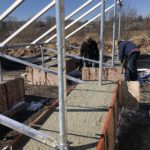
Connecticut Foundation Corporation offers residential, commercial and industrial foundation construction services in the Danbury area. For over 50 years, they’ve been a reliable choice for retaining walls, sidewalks, slabs and other poured concrete additions. Their team has the equipment, the skill and the dedication to get the job done.
New England Compost - Jeff Demers
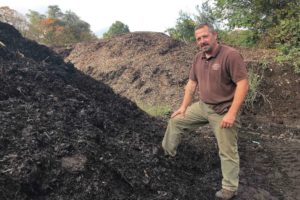
Jeff Demers brings 20 years of composting expertise to the project. His business New England Compost was established in 2001 and has grown into an artisan-style compost company. Producing premium compost and compost based soil blends through carefully sourced materials. This has allowed him to develop consistent, nutrient-rich soils for organic growers.
HRRA is gratitude for Jeff’s partnership. New England Compost has been helping HRRA transform food waste into compost since 2015. The HRRA muncipal drop-off programs throughout the region sent food scraps to New England Compost for processing. In addition, Jeff has partnered with Executive Director, Jennifer Heaton-Jones on many Back-Yard Composting workshop for residents.
Learn more about Jeff and New England Compost by visiting https://www.newenglandcompost.com/
PLEASE NOTE – NEW ENGLAND COMPOST IS NOT A RESIDENTIAL DROP-OFF FACILITY.
If you are a resident looking for a drop-off location in the HRRA region, use this link to see what municipalities have food scrap drop-off programs.
O&G Industries Inc.

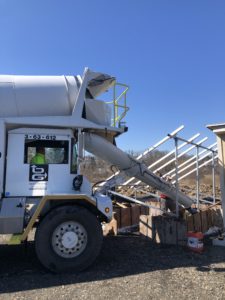
O&G is one of the Northeast’s leading providers of construction services and products. For over 90 years, O&G has completed some of the region’s most challenging projects and established ourselves as a leader in our industry – and in the communities in which we live and work. Learn more about O&G by visiting their website. O&G: About O&G: The Gold Standard (ogind.com)
Pictured above is an O&G cement truck pouring Pozzotive® into the forms to hold the solar power panels in place. Pozzotive® is a ground glass pozzolan and industrial filler made from 100% recycled post-consumer glass. It is a safer, sustainable and higher-performing material that dramatically reduces embodied CO2 emissions in concrete. Learn more about Pozzotive and the company Urban Mining that is behind the revolution of turning post consumer glass regardless of the color into an industrial building material.
We extend our gratitude to O&G for their partnership and donation of the pozzotive cement. The Town of Ridgefield was one of the first HRRA municipalities to begin source seperating glass from the single stream in 2019 to ensure the glass was recycled into a new product and not sent to landfills out of state. Learn more about the glass recycling program here. We are proud to show that we can create a circular economy through recycling right.
R.A.C.E

RACE is made up of volunteers and open to all residents who want to help our community live sustainably and be good stewards of the earth. Serving in an advisory capacity to Ridgefield’s First Selectman, our mission is to raise awareness, educate and bring about action for the:
- responsible use of energy
- conservation of natural resources, and
- reduction of waste
Recycle CT Foundation - Lee Sawyer Grant
The HRRA is honored to have been a recipient of the RecycleCT Lee Sawyer Grant. The HRRA received $15,000 to help build the Ridgefield ASP composting site.
04/23/2021 RecycleCT Announced New Grant Honoring Lee Sawyer
Late DEEP Chief of Staff Was Instrumental in Creation of Recycle CT Foundation
The Connecticut Department of Energy and Environmental Protection (DEEP) and the RecycleCT Foundation announced a new grant opportunity in April of 2021, the Lee Sawyer Community Waste Reduction and Recycling Grant, which supports waste reduction and reuse in addition to recycling and composting efforts.
The grant program is named in memory of former DEEP Chief of Staff Lee Sawyer, who died unexpectedly on Oct. 31, 2020. Lee was incredibly dedicated to the mission of DEEP, and was instrumental in the creation of the RecycleCT Foundation.
The RecycleCT Foundation is a nonprofit organization whose mission is to promote the importance of managing materials more sustainably through waste reduction, reuse, recycling and composting that encourage people, government entities, businesses, schools and organizations to adopt these practices as part of their everyday lives or operations. RecycleCT provides statewide promotion of recycling; creates educational materials available for printing that can be co-branded by municipalities, haulers and others; conducts research, including a recent recycling economic information study; and offers grant programs.
“Improving Connecticut’s waste management systems and solving the state’s waste crisis was hugely important to Lee, both personally and professionally,” DEEP Commissioner Katie Dykes said. “This new grant program is a fitting way to honor his memory, and a great way to continue the critical work he was so involved in. Connecticut’s waste system is at a crucial juncture, and through the continued work of initiatives such as the Connecticut Coalition for Sustainable Materials Management and this grant program, we’ll start to realize the modern waste system we desperately need in our state.”
“We’re pleased we can offer RecycleCT’s new grant program, which emphasizes the importance of waste reduction and reuse equally to recycling and composting programs, at a time when there is such a great need,” said Suzie Huminski, Sustainability Coordinator at Southern Connecticut State University and a RecycleCT Board member. “I can’t think of a better way to honor Lee Sawyer.”
Learn more about the grant HERE
Ridgefield Boy Scouts
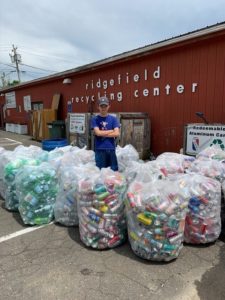
“ScoutsCAN is a collaborative effort by all four Ridgefield Scout troops to help our neighbors in need thru local non-profits and social services. Scouts bag the deposit cans and bottles collected at the Ridgefield Recycling Center. In addition to helping residents, proceeds from the $.05 deposits captured also benefit local conservation and environmental sustainability groups. Scouts live out their slogan – Do a good turn daily!”
The Ridgefield Boy Scouts made a significant contribution to the ASP project and donated $1000.00! HRRA extends our gratitude to the scouts and the families who have volunteered countless hours to raise money for the community through their “ScoutCAN” program. And to the many Ridgefield residents who donate the cans and bottles for the Scouts to utilize.
The funds will be used to purchase material for the solar housing shed that was not in the original budget! Thank you Ridgefield Scouts for helping make this project a success!
Ridgefield Supply
The Ridgefield Supply Company has its roots in a lumber company founded in 1883. The 4 ½ acre site on Prospect Street, now occupied by the retail outlet, started out as the Osborn and Gilbert Lumberyard. Please learn more about Ridgefield Supply by visiting their store location or their website About Ridgefield Supply Company
The HRRA extends our sincere gratitude to Ridgefield Supply for donating the supplies to build the housing for our solar power equipment. The shed pictured to the left was built by volunteers from R.A.C.E., lead by Dwayne Escola.
Solar-21st Century Electricity, LLC - Dwayne Escola

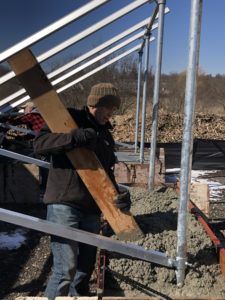
Dwayne Escola is a transplant from California’s Silicon Valley where he received his master’s in electrical engineering and spent most of his career developing computer products for IBM and Panasonic. While at IBM he also spent 6 years in Japan where among other products helped developed a Kanji printer. Dwayne moved to Ridgefield in 1994 with his wife and four sons. In 2009 he was a founding member of Northeast Smart Energy LLC where he designed and installed solar systems, including systems on several CT schools, including Farmingville Elementary School in Ridgefield. Dwayne has served as a member of the Ridgefield Zoning Board of Appeals, the Ridgefield Action Committee for the Environment (RACE) and the Town’s Energy Task Force. He has also arranged the financing for solar systems for all nine Ridgefield schools in the form of Power Purchase Agreements (PPAs), which require no Town capital. He is now retired and occasionally does solar consulting.
Dwayne without a doubt dedicated more time and energy into this project than any other partner or volunteer to date. His extensive background in solar was an asset to this project. Dwayne not only consulted and helped build the solar unit, he organized and led a team to build the housing shed for the equipment, assistant staff in the purchasing material and obtained contributions from many of the partners who donated to the project. The HRRA extends enormous gratitude to Dwayne for providing his expertise, energy and passion into this project.
USDA - Community Compost & Food Waste Reduction (CCFWR) Grant
The U.S. Department of Agriculture (USDA), Natural Resources Conservation Service (NRCS), under the Office of Urban Agriculture and Innovative Production (OUAIP), solicited applications from local governments to host a Community Compost and Food Waste Reduction (CCFWR) pilot project for fiscal year (FY) 2021.
PROGRAM DESCRIPTION
The authorizing statute for this opportunity is The Agriculture Improvement Act of 2018, Title XII, Part C, Section 12302, Public Law 115-334.
The purpose of CCFWR is to provide assistance through a cooperative agreement to U.S. municipalities, counties, local governments, tribal governments (State-designated Indian Tribes, Federally Recognized Indian Tribal Governments) or city planners. Objectives supported by the CCFWR are—
- Generate composted materials.
- Increase access of agricultural producers to composited material.
- Reduce reliance on, and limit the use of, fertilizer.
- Improve soil quality.
- Encourage waste management and permaculture business development.
- Increase rainwater soil absorption.
- Reduce municipal food waste.
- Divert food waste from landfills.
The HRRA was honored to be a recipient of this grant. The anticipated Federal share is $72,656.58 and the non-Federal share is $25,610.94 for a total of $98,267.52.
Through Community Compost and Food Waste Reduction (CCFWR) Projects, USDA is investing approximately $1.92 million in 24 pilot projects to develop and implement strategies for municipal compost plans and food waste reduction plans. USDA prioritized projects that anticipate or demonstrate economic benefits, incorporate plans to make compost easily accessible to farmers, including community gardeners, integrate other food waste strategies, including food recovery efforts and collaborate with multiple partners.
Recipients included projects in Alaska, Arizona, California, Connecticut, Florida, Georgia, Hawaii, New York, North Dakota, Ohio, Oregon, Pennsylvania, Texas, Virginia, and Wisconsin.
For a complete list of grant and cooperative agreement recipients and project summaries, visit farmers.gov/urban .
Young's of Ridgefield Fencing & Landscaping
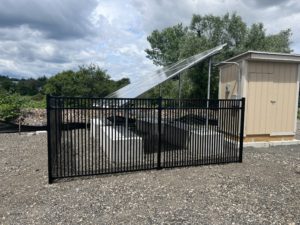
Established in 1948, Young’s of Ridgefield offers high quality custom fencing, wood fencing, vinyl fencing, aluminum fencing, chain-link and deer fencing, gates and arbors, as well as residential estate property maintenance and landscaping. They take pride in their ability to exceed their client’s expectations from first call through project completion. Their professional installation team has a combined 60 years of experience. Please learn more about Young’s by visiting their website Young’s of Ridgefield – Fencing, Landscaping (gotoyoungs.com)
The HRRA thanks Dan Rella and his company Young’s of Ridgefield for donating and installing the fencing around the solar unit to keep everyone safe.
Become a Volunteer
Would you like to become a volunteer to help grow this program?
Please click on this link and sign-up!
THANK YOU!!!

